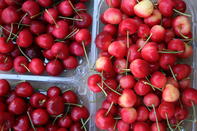South Africa’s production of sweet cherries, 0.1% of total world production, is a tiny amount compared to other southern hemisphere countries like Chile, whose main export market is China, and Argentina, who exports to the USA.

About 22% of South Africa’s cherry production is exported, with about 56% of cherry production satisfying a very healthy local demand. Half of the South African exports go to the UK.
South Africa’s cherry production is growing, with hectares increasing by 78% from 221 ha to 388 ha between 2013 and 2018. About 40% of South Africa’s cherry orchards were planted in 2017 and 2018.
World Production of Cherries
Sweet cherries, Prunus avium, is native to parts of Europe, Turkey, Africa and Asia and indeed, some of the main cherry-producing countries e.g. Poland and Turkey, are located here. The top-three producers of sour cherries for baking are Russia, Turkey and Ukraine.
Since 2001 world sweet cherry production has increased by 52% with Turkey losing its position as the top cherry producer in the world in 2016 when Chile took over. The other members of the top-five are the USA, Uzbekistan and China. South Africa is in 34th place with an annual cherry production of just over 1 000 tonnes.
A massive increase is seen in the cherry production in Chile. An increase of 353% over 16 years until 2016 has advanced them into the top-10 cherry producing countries, becoming a major exporter to Asia and supplying 80% of China’s consumption. In 2016, they produced 26% of the world’s production and their projection for the 2018/19 season was 150 000 tonnes.
The growth in China’s production was even more spectacular. An increase of over 1 800% in the years between 2001 and 2016 has seen China become a major player, with orchards ranging from old cultivars on less than half a hectare to ultra-modern farms of over 100 000 trees planted to high-density. In China, the cultivation of cherry trees in half-hoop greenhouses ensures fruit in the in-between season of late southern hemisphere and early northern hemisphere, when cherry availability is limited.
The projection for China’s 2018/19 cherry season was 210 000 tonnes. According to the United States Department of Agriculture (USDA) the world cherry production for 2018/19 was projected at 3.3 million tonnes, an increase of 156 000 tonnes. A 30% increase is predicted for Europe, especially in Poland whose cherries contribute to about a third of EU production.
Cherry Production Areas in South Africa
The climates of the eastern Free State around the towns of Ficksburg, Clocolan and Fouriesburg and the Ceres area of the Western Cape - cold winters, mild summers - are suitable for cherry farming in South Africa.
The majority of cherries, 71%, is produced in the Western Cape, 13% in the Free State and 10% in the North West Province.
The total production of cherries in South Africa was 1 024 tonnes during the 2018/19 season.
Cherry Markets
About 55% of South African cherries are sold in South African stores and markets. About 22% is exported and less than 10% is processed. Johannesburg and Durban are the biggest markets, each absorbing 33% of local cherry production. Pretoria sells 21% and Cape Town only 9% of South African cherries.
Of the exported cherries, about 50% is going to the UK, 24% to the Middle East, 16% to Europe and Russia. Some other markets receiving South African cherry exports are other African nations and the Far East 3% each.
By Marinda Louw
For bulk or Cherries export enquiries please use the enquiry link below.